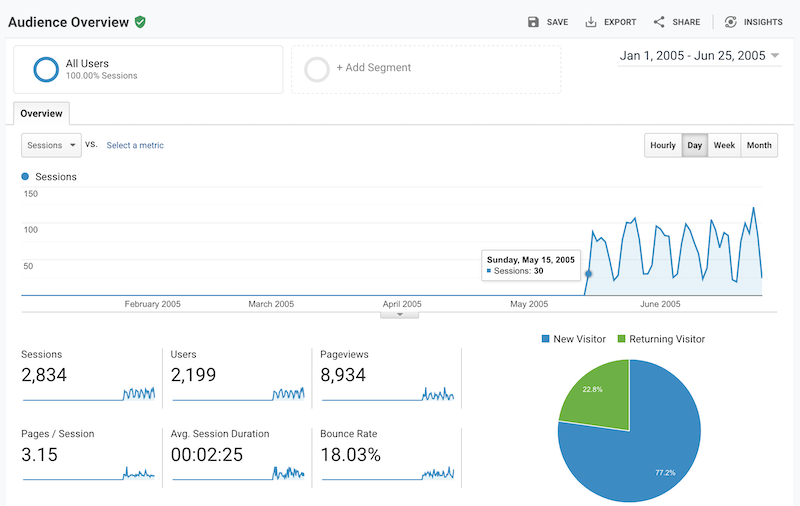My first Google Analytics data point was 15th May 2005 for UA-20024. If you are of a certain age, that may sound off because GA did not launch until 14th Nov that year. Essentially, this was my Urchin software account that was migrated to GA in those early days of the acquisition. Amazingly, the account was still running strong with 18 years of data retention… wow!
No other tool has revolutionised the data industry like Google Analytics has. An industry that in 2005 we estimated to be approx. 30,000 accounts, is now of the order of 40 million, with the vast majority of those using Google Analytics. As an aside, the industry grew by 100,000 accounts within the first week of launch! Adoption was so rapid, we had to close the sign up process for a year due to lack of processing power/storage at Google.
Google’s secret? Make it free.
Back in 2005, vendors providing a free version of their tool meant very basic features that were of little use unless you ungraded to their paid version. But then came Google’s redefinition of what “freemium” means – giving away pretty much ALL features at no cost – charging only if you required more horsepower i.e. more data processing, more storage. The free threshold was a very generous 10M hits per month (around 1M visitors). Even today, no other tool comes close to that industry defining approach.
Having all of the features to play with for free, meant anyone with a website could play with “big data” and train themselves to be an analyst. That is exactly how I got started with its predecessor, Urchin Software – applying my scientific training to figuring out how to measure success.
This is what I was working with in those early days of Google Analytics:
A career defined by Google Analytics
I have built my career on the back of Google Analytics – firstly by using Urchin Software, circa 2002. I still remember being blown away by its simplicity to set up (server-side tracking is not as new as you might think!) and its ease of use when it came to interpreting the reports and understanding user actions. I felt like I had stumbled upon something quite important and I wrote numerous articles about it – remember this pre-dates WordPress by some years.
Then I joined Google in 2005 to help launch this new era as their first Head of Web Analytics for Europe. I wish I had kept a diary of these times – so much happened. Its was chaotic, fun, inspiring, stressful. Acquisitions flew by me: Keyhole, Writely, YouTube, DoubleClick, Android…, became Google Maps, Google Docs etc.. The company doubled in headcount each year from around 3000 when I joined, to 6000, then 12000 and 20k. Imagine that growth. Despite that chaos, I am particularly proud of the training certification I built at Google that went on to become the GAIQ.
By 2008 I really wanted to write a deep-dive book about Google Analytics. I had an itch so to speak, and a unique perspective as both a practitioner and working behind the scenes. So I left Google and went on to write four books on the subject (book 3 nicely timed with Universal that launched in 2012).
Even now Google Analytics is still a big part of day to day work. Looking back I found this slide showing its development over time. Universal launched in Phase 3 – maybe that is why is it sometimes referred to as GA3 ; )
End of an Era, or the Start of a new one…?
Its been a fantastic journey Google. Its been emotional. Although times have changed and everything is now all about GA4, I will miss Universal Analytics. Building custom reports, custom funnels, custom content groups – was so intuitive and a pleasure to work with. Within minutes you could have some pretty powerful information at your fingertips. And for more advanced users you had the customTask API – a great way to manipulate a data hit at the point it was being generated.
Universal had its faults of course: The Measurement Protocol was notoriously insecure; Cross domain set up was way too complicated and easy to break; Event tracking (and tracking in general) was very rigid – though that can also be interpreted as well-structured in a world of unstructured data; GA360 was incredibly expensive with a one size fits all price tag of $150,000 per year; Report sampling of custom reports was a real PITA. However with all that that said and done, Universal Analytics was a great product imho.
Will GA4 herald in a new era…?
Of course GA4 is needed in order to have a fresh approach and therefore be able to build new features that were not previously possible. But to answer my own question, no I don’t think Google will dominate in the way it has before. The adoption curve will not continue to go up and to the right, rather I expect it to fall – partly because of the privacy issues that adtech is now facing, but mostly because the tool is simply not a good fit for most users.
As a wise person once said to me:
“Advanced web metrics is about doing the basics very well and applying it in a clever way.”
Whilst the underlying data model of GA4 is undoubtable better than Universal i.e. a lot more flexible with all events essentially treated as equal, there is still a lot of work to be done. Shiny new features cannot hide the fact that GA4 does not do the basics well enough. In that respect, it is a downgrade from Universal.
GA4 will need to fix these basic issues to maintain its user base:
- The infuriatingly clunky user interface;
- Inconsistent metrics;
- The opaqueness of Google Signals and its arbitrary thresholds;
- Big Query data export where everything appears to be nested. What should be intuitive SQL statements are instead horrendously over complicated. For example, having no session parameter exported means recursively counting all combinations of
user_pseudo_idandga_session_idjust to obtain a count of unique sessions! - The crazy use of three different metrics for source/medium attribution – that is, source/medium, session source/medium, traffic source/medium – each referencing something different depending on which report you are looking at;
- The confusing mix of gtag v tag manager terminology within the product itself;
- Content Grouping reduced to only a single content group (it was 5 in Universal);
- The excessively long time lag of features appearing in APIs and its overly tight quota limits;
- The complete lack of a GA4 “settings variable” in GTM – effectively killing it’s scalability.
I could go on, but Simo Ahava and Lukas Oldenburg have already written eloquently about GA4 frustrations. They are well worth a read.
With its huge head start of inheriting the Universal Analytics user base, GA4 certainly has the potential to remain the biggest vendor in this industry – mostly due to its excellent freemium approach and its easy integration with all of Google’s advertising products/ecosystem. However, being constantly told to “go and use Big Query” or “build a report in Looker Studio” to answer basic marketing questions, is an annoying sledgehammer approach that is simply not tenable. At the moment, GA4 feels very much like a alpha product – lacking many of the basic features that are needed for every day analysis.
My last Universal Analytics data point
When I started in this industry, people did not want niche analytics tools. On the contrary, they wanted standardisation and Google Analytics filled that void perfectly. Now I detect a real interest in niche tools again and I am as curious now as I was when I first installed Urchin. My next post will explore this more.
Rex mortuus est, vivat rex.







0 Comments